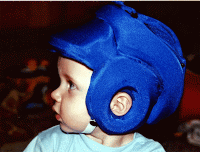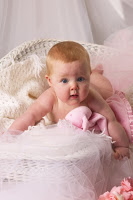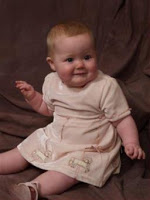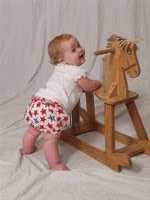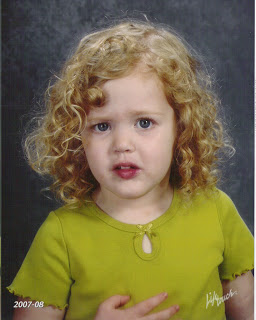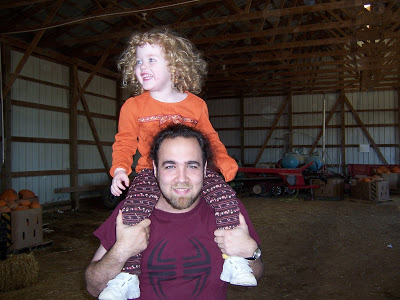Over the weekend, we went to a big gathering hosted by some friends. Most of us have kids, so all of the kids got to play together. Cordy has played with the hosts’ two children several times before without any problems. The five year old sometimes gets annoyed with Cordy, but in that case he usually just ignores her.
But the dynamics were different this time. The five year old had a seven year old friend, and the two of them were playing together. Cordy and the two year old were also in the playroom. Now, looking at these four kids, you’d think Cordy belonged with the older two – she is only slightly shorter than the five year old, and may outweigh him. And of course the older two were having a great time making up their own games and creating imaginary worlds to play in.
The trouble started when the five year old brought out a new magnetic fishing pole. He and the seven year old girl immediately threw the fish on the ground and started fishing. Cordy – having little self-control – loved seeing the pole and grabbed for it so she could fish, too. The older kids screeched at her and yanked the pole back.
I stepped in at this point and reminded the older kids that Cordy was younger than them, and had trouble understanding the concept of waiting for her turn. I then focused on Cordy, explaining that she had to wait until they were done before she could have her turn, and that she couldn’t take away toys from other kids. I also tried to redirect her to another toy, but she was obsessed with the fishing pole.
The older kids went back to fishing, laughing with excitement. The energy the two of them generated could have powered half of Ohio. Cordy, still standing on the sidelines, couldn’t take it anymore. She again reached out and put her hand on the fishing pole, saying “Cordy catch a fish? Cordy catch a fish?”
The older kids again removed her, although in pushing her away from them, Cordy pushed back. I reminded Cordy that she shouldn’t push. I could see the frustration on her face. “Cordy catch a fish!” she cried and reached again for the pole.
“No!” yelled one of the older kids. “Cordy will NEVER catch a fish! Never!” They then picked up a fish and ran around the large wooden puppet theatre in the room to “cook it”. But they took the pole with them, too.
Cordy looked confused and hurt. Those harsh words hurt me, too. This social situation for Cordy was quickly turning bad and I wanted to pluck her out of it. But she was determined to get that fishing pole. As I tried to talk to her, she walked around the puppet theatre to join the other two. They had set the pole down for the moment, so she took the opportunity to pick it up. They quickly noticed, and a round of “No, Cordy!” erupted as they both grabbed her and pulled the pole from her.
The cartoon steam was coming from her ears at this point. She didn’t understand why she couldn’t have a turn, she didn’t know why they were being mean to her, and she really wanted to play with this toy. I could see the inner workings of her mind on her face – she was furious, frustrated, and what little reason and logic she had were no longer accessible. I watched her progress to the edge of a full-blown, out-of-her-right-mind meltdown, teetering ever so close on the precipice.
Cordy reached out and grabbed the (very heavy, and a little unstable) puppet theatre and started shaking it violently. The older kids yelled at her to stop. I also firmly told her to stop because it was rocking enough that I worried it would fall on them. In those seconds, I knew what I had to do, but also knew the results: the first person to touch her was going to set her off into a screaming, kicking meltdown, but it was important that she didn’t knock down the wooden structure.
I told her once again to stop, and grabbed her hand. As if I had some kind of jelly touch, she immediately collapsed and began wailing. I scooped up the seemingly invertebrate preschooler and moved her to another room. Aaron heard the screaming from upstairs and joined me as we held Cordy tight to prevent her from hurting herself as she flailed and screamed wildly.
She calmed down faster than I expected. After 15 minutes, she had calmed down enough to join the adults and sit with me, sniffling and coughing. We again talked about toys that belong to other kids, and how she could only play with those toys if the owner said it was OK. But the situation had turned into more than a fight over a toy.
“Do you want to go back downstairs with the other kids?” I asked.
“Nooooo!” she cried, hiding her face in her hands. She was scared to play with them again. Her attempt to play in a social situation was a disaster, and she didn’t want another try. She was happy to remain with the adults, close by my side.
There is a somewhat happy ending, though. Later in the evening, she did venture downstairs to play again, this time abandoning all attempts to interact with the older kids. They had moved onto a different game, so she quietly took the fishing pole and caught several fish, proudly showing me each one.
And I in no way blame the other kids for what happened. They were acting like average five and seven year olds – I wouldn’t expect them to act any other way. I can see how Cordy would annoy them. Cordy’s new attempts to play with other kids often results in her approaching kids older than her, and these kids don’t know how to deal with her. (Let’s be honest – I don’t always know how to deal with her.) She looks like she’s as old as them (even though she’s three), but at the moment she can’t understand the rules of social interaction.
I think I was the one most affected, though. In true kid fashion, she seems to have forgotten most of what happened, while I play it over and over in my head. I wonder if I should have stepped in sooner, or not stepped in at all and let her navigate the murky social waters on her own. I know I can’t always be there to interfere, and I don’t want to be some helicopter mom. But every injury to her feelings seems to strike me twice as deep.
This is a whole new area of parenting that I’m not sure I’m ready for. Helping her learn to crawl and eat solid foods was much easier than helping her deal with the world of best friends, you’re-not-my-friend-anymore, teasing and cliques. I was never any good at that area myself, so I have no idea how to teach her how to deal with it. We’re both going to need tougher skin, I think.
